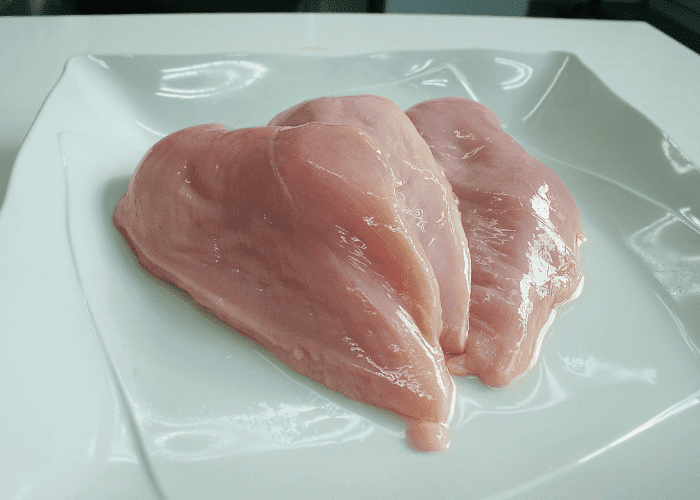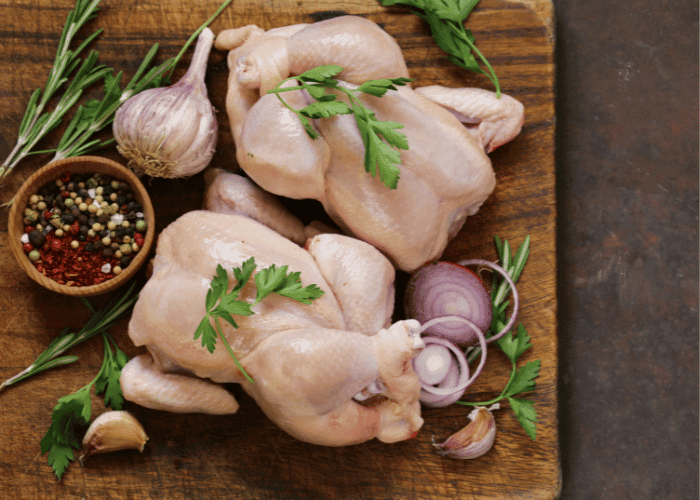Chicken, a chicken cut that is both adaptable and common, is used in a broad variety of cuisines all around the world. Because of its delicious flavor, it is a fan favorite among people who like eating. However, have you ever looked at chicken meat and spotted a vein?
If so, you’ve probably wondered what it is.
It’s a straightforward question with a straightforward answer: all chicken breasts contain veins, albeit some have veins that are more visible than others, particularly whenever the chicken gets cooked upon that bone.
Here, we will discuss all Veins in Chicken – Why, and How to Get Rid of It?
Veins in Chicken – Why, and How to Get Rid of It?

If you have a chicken that has not been cooked.
You may trim it so that the veins as well as a connective tissue that generates discoloration are removed.
This will make the chicken whiter.
Begin by locating the fat end of the breast.
There, you will notice some white substance, which represents the cartilage that joins the muscle to the chest.
This is where you should start cutting the breast.
While holding the cartilage firmly, insert a serrated knife underneath it.
This will remove the cartilage as well as any gristle that is attached to it.
You should also remove any bleeding tissue you locate beneath this area, which is likely to be vein rich.
After the excess fat has been trimmed off. Give the chicken breast a quick washing in some cold water and pat it dry with a paper towel.
If the chicken has already been cooked, removing the vein from it might be a more difficult task.
It’s better to remove the entire breast from the bone before separating the sensitive interior part from the outside breast flesh.
The outside part will not normally include any veins.
Therefore, it may be cut like any other piece.
Tenderloin vein removal requires running a sharp knife under the vein and lifting it up and out in little increments along its length.
It’s possible to carefully and slowly remove the vein from your body and throw it away.
Even if the tenderloin comes apart while cooking, you can still make use of it by adding it to a salad or making a sandwich with it because it is a wonderful and juicy section of the chicken.
Where can I find the Chicken’s Vein?

Chicken with a strangely colored thread, such as red, pink, or purple, is perfectly safe to eat, raw or cooked.
Just as veins in human muscle tissue are crucial for delivering blood to working muscle tissue, so too are the veins in chicken flesh.
It is usual to see the vein in chicken meat flowing along the tenderloin, which is the innermost region of the breast and is located closest to the bone.
This tenderloin is cut from the juicy and luscious section of the chicken breast, which is why it is typically used for making chicken tenders.
The tendon, which is a thin line that runs through the meat, can be found in close proximity to the vein.
When the tendon is cooked, it softens and incorporates itself into the flesh, which makes the vein nearly impossible to detect.
Do All Chicken Have Veins?

It’s possible that you’ve been preparing chicken for years without ever noticing the veins until one day, while you’re preparing a chicken breast, you discover a dark crimson vein running through it.
What accounts for the difference?
The manner in which the chicken was killed affects how noticeable the vein is in the flesh of the bird.
Veins are present in every chicken, but in some of them, you can hardly see them.
When the meat is cooked, the hemoglobin in the veins might turn a purple color when it is subjected to heat, which makes the veins stand out more against the white background of the cooked flesh.
Veins are often more obvious in active muscles, such as the legs and wings of an animal, whereas breast flesh typically has fewer veins, but they can still be seen there.
The changes in hemoglobin between the blood arteries and the brain tissue that occurs when grilling chicken upon that bone can also accentuate the veins.
The chicken breast is often removed from the bone, but the veins are left in place by most butchers.
To summarize, the presence of veins in chicken flesh is natural and there is no need for anyone to be alarmed by this fact.
Veins in chicken flesh may or may not be visible, depending on the size and location of the veins, the butchering method, and the cooking method.
The taste of the chicken won’t change, regardless of whether or not there is a vein in it, so don’t worry about that.
Is It Okay to Consume the Veins Found in Chicken?

A good number of us have pondered the question of whether or not the veins that are occasionally visible in chicken breasts are fit for human consumption.
The correct response is “yes.” It is in no way risky to consume the veins that can be found in chicken.
When we consume meat, we are in reality swallowing capillaries, which are very small veins.
This has been going on for years without causing us any problems.
Because the blood is drawn out of the chicken during the slaughtering process, there is no danger posed by the bird’s veins because they are simply enlarged copies of these capillaries.
But be sure the chicken is well cooked before serving.
The existence of a vein in the meat can cause it to become discolored, giving it a tint that is anywhere from pink to red to even purple.
Because this is typically a symptom of chicken that has not been cooked thoroughly, it is critical to check that the chicken has been cooked through other means.
Checking the temperature of the meat’s inside with a thermometer designed specifically for use with meat is one way.
According to recommendations made by professionals in the field of food safety, chicken and other fowl should be cooked to a core temperature of 165 degrees Fahrenheit before being consumed.
The color of the fluids that are expelled from the meat is another option that you have.
The chicken is considered to be completely cooked if the juices run clear.
You know it needs more time in the oven if the inside is still pink or crimson.
Veins in Chicken: Is It Possible to Avoid?

Avoiding the veins that are seen in chicken breasts may be desirable for those individuals who find the veins to be unpleasant.
You can lessen the likelihood of receiving chicken without veins by purchasing them from a butcher.
The butcher will be able to prepare the chicken breasts in accordance with your preferences.
However, you should be aware that this is not a guarantee.
You should request the butcher to cut the vein out of the chicken breasts for you.
Veins in the chicken are also less common when the chicken is boneless rather than cooked with the bone.
Before You Buy Chicken, There Are Several Precautions You Should Take.

The safety of eating chicken breasts with veins intact is just one of several considerations while cooking chicken.
To begin, it is essential to select chicken that is of excellent quality and that was both reared and processed in a responsible manner.
This improves the flavor and tenderness of the chicken, in addition to making it more hygienic for human consumption.
Look for chicken that comes from farms or butcher shops that have a good reputation, and steer clear of any chicken that smells rancid or seems slimy or has changed color.
It is essential to make use of the appropriate techniques and strategies while preparing chicken for cooking.
The chicken may be cooked deliciously by broiling, roasting, or sautéing.
But it is essential to keep an eye on the internal temperature to ensure that it does not get overcooked in any of these methods.
Chicken that has been cooked for an excessive amount of time might become rubbery and dry, rendering it undrinkable and perhaps posing a threat to the safety of other foods.
It is best to use a meat thermometer to determine the internal temperature of the chicken.
But you may also use other ways, such as slicing into the chicken to see whether or not the flesh is cooked through.
Meat that is pink or crimson in the middle requires additional cooking time.
Conclusion
To summarize, the vein found in chicken flesh may be consumed safely.
Nevertheless, in order to eliminate the possibility of contracting a food-borne disease, it is essential to ensure that the meat is well-cooked.
It is because the vein can also produce discoloration in the flesh.
It is advisable to utilize a thermometer to check the temperature or examine the color of the fluids to determine whether or not the chicken has been cooked through completely.
Boneless chicken, chicken purchased from a butcher and afterward having the vein removed, or chicken that has been trimmed oneself are all viable options for those who find the thought of a vein in their chicken distasteful.
It shouldn’t make a difference whether or not the vein is removed.
The end result should be a dinner that is flavorful, juicy, and succulent.
That’s it from our side on the article on Veins in Chicken – Why, and How to Get Rid of It. For more informative pieces, stay connected.

